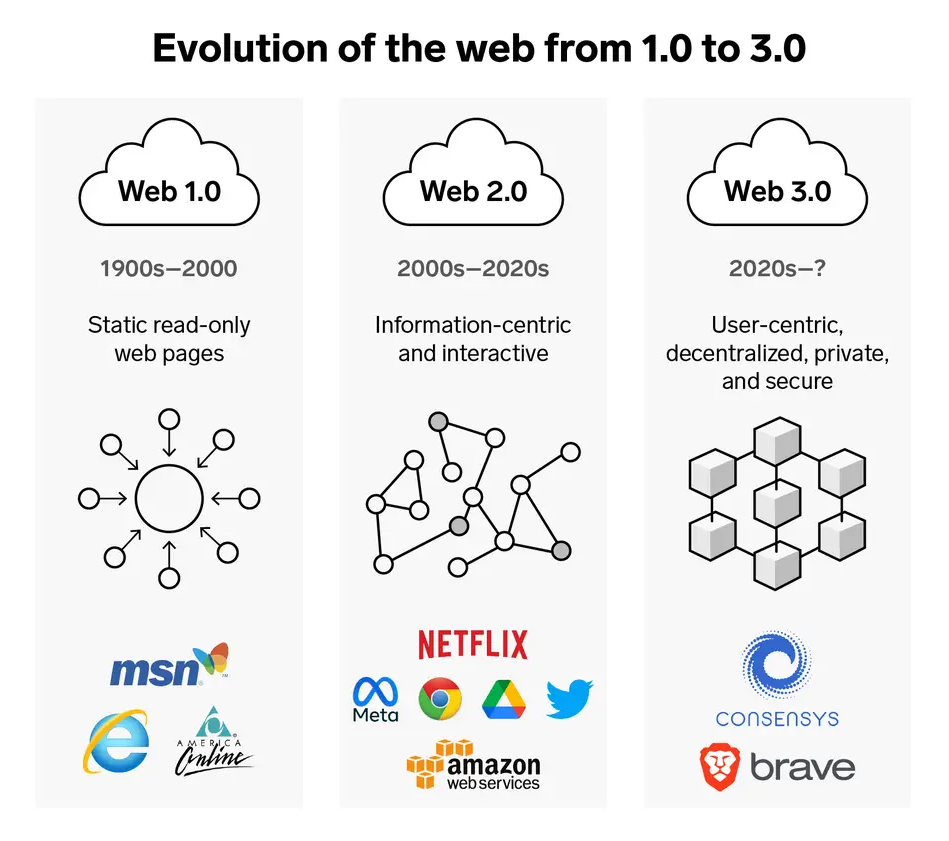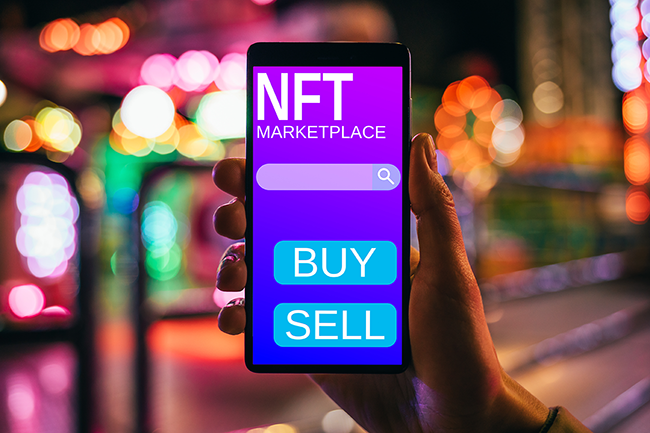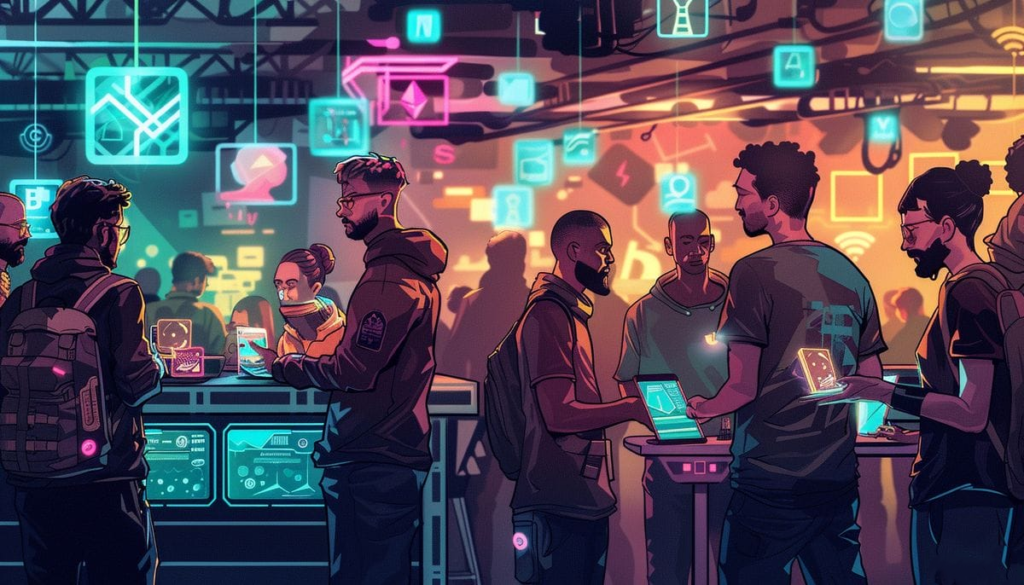As we stand on the precipice of a transformative period in technology, the advent of Web3 and blockchain technologies is ushering in a new epoch. This revolution is not merely altering our interaction with the internet, but it’s reshaping the very fabric of our digital interactions. This revolution is paving the way for a more democratic, secure, and transparent internet. With domains being the cornerstone of internet navigation, the traditional concept of domains as static addresses with be challenged, with blockchain enabling them to become dynamic, programmable assets.
Web3 & Blockchain Explained
Web3, often referred to as the decentralized web, is the next generation of the internet. It aims to create a user-centric online world where users have control over their own data and digital identities. Unlike the current web (Web2), where a few centralized entities control the majority of data and online services, Web3 is built on peer-to-peer networks, with blockchain technology at its core.

At the heart of Web3 is Blockchain. Blockchain is a type of distributed ledger technology that allows data to be stored across a network of computers worldwide. It’s the underlying technology of cryptocurrencies like Bitcoin and Ethereum, but its potential extends far beyond digital currencies. Blockchain’s key features – decentralization, transparency, and immutability – make it a powerful tool for a wide range of applications, including domains.
The importance of Web3 lies in its innovative potential. By decentralizing the internet, Web3 can empower users by giving them control over their data, disrupt traditional business models, and lead to the creation of new types of online services. Web3 can also lead to the tokenization of digital and physical assets, enabling them to be traded on Blockchain networks. This can democratize access to a wide range of assets and investment opportunities, from real estate to intellectual property.
In the context of domains, blockchain can enable domain ownership to be tokenized and traded like any other digital asset. This opens up new possibilities for domain usage, including programmable domains, decentralized website hosting, and more. This is just the tip of the iceberg when it comes to the transformative potential of Web3 and blockchain in the domain industry. As this new era unfolds, it’s clear that Web3 and blockchain are more than technological revolutions, they are a paradigm shift in how we interact with the digital world.
Blockchain’s Role in Web3
With decentralization being a key feature of Web3, blockchain plays a pivotal role because unlike traditional web services, it operates on a network of computers (or nodes). Each node has a copy of the entire blockchain, making it highly resistant to censorship and single points of failure.
Security is another crucial aspect of Web3, and again, blockchain is fundamental. The cryptographic algorithms used in blockchain ensure that transactions are secure, and that data integrity is maintained. Furthermore, the decentralized nature of blockchain means that there is no central authority that can be compromised, enhancing the overall security of the system.
Transparency is also a significant feature of Web3 and is enabled by blockchain. Each transaction on a blockchain is recorded in a block and added to the chain in a linear, chronological order. This creates an immutable, auditable trail of all transactions.
Moreover, blockchain enables the creation of smart contracts – self-executing contract with the terms of the agreement directly written into the code. Smart contracts automate transactions without the need for a middleman, which can lead to more efficient, trustless interactions.

The Evolution of Blockchain
Since its inception with Bitcoin in 2009, blockchain has undergone a significant evolution. Initially conceived as a public, permissionless ledger for recording transactions of cryptocurrency, it has grown and diversified into various types, each embodying a unique philosophy and degree of centralization.
Public blockchains, like Bitcoin and Ethereum, embody the philosophy of complete openness and decentralization. They are open to anyone and everyone, with every transaction visibly recorded and verifiable by any participant. Governance in these blockchains is typically decentralized, with changes to the protocol made through a consensus of participants. However, this openness comes with challenges, such as scalability and privacy concerns.
At the other end of the spectrum are private blockchains. These are permissioned networks where entry and participation are controlled by a single organization or entity. This control allows for greater scalability and privacy, making them suitable for businesses and organizations with specific operational requirements. However, this centralization can be seen as contrary to the original ethos of blockchain technology.
Striking a balance between these two extremes are consortium blockchains. These networks are governed by a group of organizations, rather than a single entity, offering a degree of decentralization. They combine the transparency and security benefits of public blockchains with the control and privacy of private ones. Consortium blockchains are often used in inter-business collaborations where trust, privacy, and efficiency are paramount.
Non-Fungible Tokens (NFTs) & Their Roles
You’ve probably heard people talking about NFTs, which are arguably the most talked about and least understood blockchain technologies to date. Non-fungible tokens, or NFTs, are a type of digital asset created using blockchain technology. Unlike cryptocurrencies, which are fungible and can be exchanged on a like-for-like basis, NFTs are unique. Each NFT has distinct information or attributes that set it apart from any other token, making it impossible to exchange on a like-for-like basis.
NFTs can represent ownership or proof of authenticity of a wide range of tangible and intangible items, from digital artwork and music to virtual real estate and digital identities. They leverage the transparency, security, and immutability of blockchain technology to verify authenticity and ownership, combat plagiarism, and enable the tokenization and trade of assets in a decentralized manner.
Domains in the Future of Web3 & Blockchain
In the context of Web3 and blockchain, domains are set to undergo a significant transformation. Traditional domains are centrally controlled and leased by domain registrars. However, blockchain technology will enable the concept of decentralized domains.
Decentralized domains will be owned, not leased, by the user, providing full control and censorship-resistance. These domains will exist on a blockchain, making them immune to seizure or takedowns. Furthermore, they will be able to be associated with a blockchain wallet address, simplifying the process of sending and receiving cryptocurrencies.
Web3 domains are already making their debut on the internet. Unlike traditional domain extensions like .com and .org, which are part of a centralized Domain Name System, Web3 domains offer a decentralized alternative. This centralization gives ICANN the authority to revoke or censor these domains.
In contrast, Web3 domains like .crypto, .wallet, .nft, and .coin are already being registered on blockchains like Polygon. This shift means that users have full ownership over these domains. Like any other Non-Fungible Token, users can buy, trade, or sell these domains. This represents a shift in domain ownership and management, further emphasizing the transformative period we are currently in.
The concept of domains being tokenized as NFTs, turning them into unique digital assets that can be bought, sold, or traded on the blockchain, opens up new possibilities for domain usage and ownership. For instance, a tokenized domain could be programmed to display different websites or content based on the viewer’s preferences or identity.
What Could This Mean For Your Brand?
The advent of Web3 has ushered in a new era of challenges and opportunities for brands. A significant challenge is the potential for unauthorized entities to purchase domains that mirror trademarked names, which could lead to fraudulent activities and tarnish brand reputations. Therefore, brand protection in the Web3 space has become a critical concern.

In response to this, a product called GlobalBlock was launched in the domain industry in early 2024. This innovative service offers unified domain blocking, enabling brands to prevent third parties from registering domains with protected marks in the Web2 space and purchasing them in the Web3 space.
According to Forta’s 2023 Domain Impersonation Report, brands were targeted by an average of 39.4 look-alike domains each month in Q1. However, the period from May to June saw a surge of more than 120%. This trend is not confined to the Web2 space. In the Web3 space, brands have been appearing on the NFT marketplace for years. Bad actors, without the consent of brand owners, are known to purchase blockchain domains and wait until the owner approaches them. Their objective is to sell the domain at a hefty price, as exemplified by appleinc.eth, which was listed on the NFT marketplace for a staggering $600,000 (currency unknown).
Domain blocking is a vital tool in mitigating brand infringement and ensuring a secure digital presence. It offers a proactive approach to enhancing your brand protections strategy.
GlobalBlock provides several benefits:
- Enhanced Brand Protection: It allows you to stay ahead of potential threats and brand infringement by proactively securing your brand’s online presence.
- Unprecedented Scale: It enables you to block brand names and marks at scale across all extensions offered by GlobalBlock.
- Web3 Advancements: GlobalBlock represents a milestone in Web3, making domain blocking a viable and effective strategy for brands navigating the decentralized web.
Webnames Corporate offers the GlobalBlock product, giving companies the ability to protect their brand across over 500 Web2 extensions, and (currently) 20 Web3 extensions. This comprehensive coverage ensures that your brand remains secure in both the traditional and decentralized web spaces.
| .NFT | .X | .CRYPTO | .BLOCKCHAIN |
| .BITCOIN | .ANIME | .POLYGON | .DAO |
| .UNSTOPPABLE | .WALLET | .888 | .GO |
| .ZIL | .KRESUS | .KLEVER | .HI |
| .MANGA | .BINANCEUS | .PUDGY | .AUSTIN |
Web3 extensions currently covered by GlobalBlock
But Wait… There’s More To It.
A bridge exists between the traditional internet (Web2) and Web3 – domains that straddle both spaces. These domains extensions are designed to work in both Web2 and Web3 environments. There are some extremely interesting examples of this:
This is the first and currently only domain registry known to offer matching ENS (Ethereum Name Service) and DNS (Domain Naming System) domains. This innovation by .ART establishes a connection across Web2 and Web3 platforms, allowing users to have a single name that works on both. For example, if you own yourname.art as a DNS domain, you can also purchase yourname.art as an ENS domain pointing to any digital asset on the Ethereum blockchain. The same name can also be used as a web address in any browser pointing to a website and as an email address.
.LOCKER
.LOCKER offers a traditional domain name paired with a Bitcoin-secured digital identity. This means it bridges Web2 domains with Web3 digital identities, linking them to the same user. It’s designed for users who are curious about Web3 and those who are ready for it, offering the full functionality of their domain name, such as website and email capabilities, and a corresponding Web3 digital identity to use for specific applications like DeFi, managing crypto assets, and Web3 social networks.
.BOX is a unique TLD that operates at the intersection of traditional web infrastructure and blockchain innovation. With tokenized domain ownership, .BOX harnesses the power of blockchain as they are issued as NFTs, providing undeniable proof of ownership and control over the domain. It supports multi-signature wallets, allowing multiple parties to manage a domain jointly, a feature that requires consensus for significant changes or transactions. It also integrates Web3 payment options seamlessly, enabling direct cryptocurrency payments to .BOX domains. This integration embeds the financial transactions into the fabric of your online identity, simplifying the process. .BOX also offers enhanced website loading speeds and reduced transaction costs through integration with advanced technologies like 3DNS and the Optimism blockchain. It allows .BOX owners to have a unified Web3 identity via its integration with the ENS. It is both ICANN and DNS accredited.

Progress of Web3 & Blockchain in 2024 & Beyond
Over the past few years, we have seen significant advancements in this field. From the proliferation of decentralized applications (dApps) to the rise of decentralized finance (DeFi), the Web3 ecosystem is growing at an unprecedented rate.
Blockchain has also made significant strides. It has found applications beyond cryptocurrencies, with industries like supply chain, healthcare, and real estate harnessing its potential for transparency and immutability. The development of scalable solutions, such as Layer 2 protocols and sharding, has addressed some of the inherent limitations of blockchain, paving the way for mainstream adoption.
The Road to Reality
Despite the progress, the journey towards a fully decentralized web is far from over. There are still numerous challenges to overcome, including regulatory hurdles, technological limitations, and public skepticism. Moreover, achieving the level of user experience and functionality that today’s internet users are accustomed to is a significant task.
However, the pace of innovation in the Web3 and blockchain space is promising. With continued research and development, collaboration between stakeholders, and favourable regulatory frameworks, the vision of a decentralized web could become a reality sooner than we think.
While we are still in the early stages of this technological revolution, the progress made so far is encouraging. The road to a decentralized future may be long and winding, but the destination promises to be worth the journey. The dawn of Web3 and blockchain is upon us, and it’s only a matter of time before they become an integral part of our digital lives.
If you’ve got questions or concerns about how to protect your brand from Web3 and/or blockchain domains, please contact one of our brand specialists to put together a robust strategy to mitigate any future problems.
Glossary
3DNS: The first on-chain domain registrar that is compatible with both Web2 and Web3. Domains registered or transferred into 3DNS are NFTs in your wallet, secured by your private key.
Optimism Blockchain: Optimism is a Layer 2 solution for the Ethereum blockchain, designed to address the scalability issues of Ethereum. It operates on top of Ethereum’s architecture, acting as an extension of the main Ethereum layer. This technology is powered by a mechanism called Optimistic rollups, which bundle large amounts of transaction data into manageable batches.
Decentralized Applications (dApps): A software program that runs on a blockchain, or peer-to-peer (P2P) network of computers instead of a single computer. Unlike traditional applications that operate under the control of a single authority, dApps are spread across the network to be collectively controlled by its user. The key features of dApps include safeguarding user privacy, the lack of censorship, and the flexibility of development. For example, a developer can create a Twitter-like dApp and put it on a blockchain where any user can publish messages. Once posted, no one except the message originator can delete the messages. This makes dApps free from the control and interference of any single authority.
Decentralized Finance (DeFi): An emerging financial technology that operates on secure distributed legers, similar to those used by cryptocurrencies. DeFi aims to remove third parties and centralized institutions from financial transactions. It uses cryptocurrencies, blockchain technology, and software to allow people to transact financially with each other. Unlike traditional financial systems where centralized entities like banks and brokerages define the rules and control access to capital and financial services, DeFi empowers individuals with peer-to-peer transactions. This system eliminates the need for intermediaries like banks and other financial companies, which charge businesses and customers for using their services. DeFi is still in its infancy and subject to risks such as hacking and thefts due to sloppy programming and a lack of due diligence in security testing before applications are launched.
Layer 2 Protocols: Also known as network L2 protocols, these are a set of communication protocols used by Layer 2 devices such as network interface cards (NIC), switches, multiport bridges etc. These protocols are responsible for transferring data in a wide area network, or between one node to another in a local area network. These protocols also manage how a computer on your network gains access to data and permission to transmit it. Examples include Ethernet, the IEEE 802.11 WiFi protocols, ATM, and Frame Relay. Depending on how a frame is transferred, it can be categorized as Unicast (between 2 individual nodes), Multicast (one node to multiple nodes), or Broadcast (transmitting nodes across the network.)

